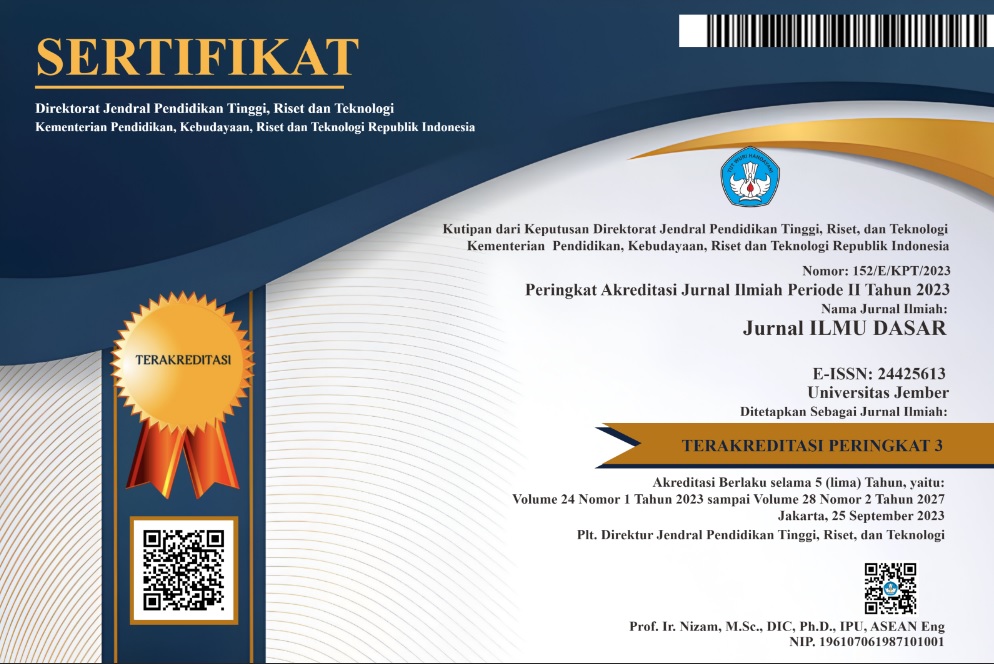Local Stability Dynamics of Equilibrium Points in Predator-Prey Models with Anti-Predator Behavior
DOI:
https://doi.org/10.19184/jid.v22i2.23991Abstract
This article describes the dynamics of local stability equilibrium point models of interaction between prey populations and their predators. The model involves response functions in the form of Holling type III and anti-predator behavior. The existence and stability of the equilibrium point of the model can be obtained by reviewing several cases. One of the factors that affect the existence and local stability of the model equilibrium point is the carrying capacity (k) parameter. If x3∗, y3∗ > 0 is a constant solution of the model and ∈ (0,x3∗), then there is a unique boundary equilibrium point Ek (k , 0). Whereas, if k ∈ (x4∗, y4∗], then Ek (k, 0) is unstable and E3 (x3∗, y3∗) is stable. Furthermore, if k ∈ ( x4∗, ∞), then Ek ( k, 0) remains stable and E4 (x4∗, y4∗) is unstable, but the stability of the equilibrium point E3 (x3∗, y3∗) is branching. The equilibrium point E3 (x3∗, y3∗) can be stable or unstable depending on all parameters involved in the model. Variations of k parameter values are given in numerical simulation to verify the results of the analysis. Numerical simulation indicates that if k = 0,92 then nontrivial equilibrium point Ek (0,92 ; 0) stable. If k = 0,93 then Ek (0,93 ; 0) unstable and E3∗(0,929; 0,00003) stable. If k = 23,94, then Ek (23,94 ; 0) and E3∗(0,929; 0,143) stable, but E4∗(23,93 ; 0,0005) unstable. If k = 38 then Ek(38,0) stable, but E3∗(0,929; 0,145) and E4∗(23,93 ; 0,739) unstable.
Keywords: anti-predator behavior, carrying capacity, and holling type III.
Downloads
References
Agarwal, M., & Pathak, R. (2013). Persistence and Optimal Harvesting of Prey-predator Model with Holling Type III Functional Response. International Journal of Engineering, Science and Technology, 4(3).
Ives, A. R., & Dobson, A. P. (1987). Antipredator Behavior and The Population Dynamics of Simple Predator-prey Systems. American Naturalist, 130(3): 431-447.
Křivan, V. (1998). Effects of Optimal Antipredator Behavior of Prey on Predator-prey Dynamics: The Role of Refuges. Theoretical Population Biology, 53: 131-142.
Li, C., Zhang, Y., Xu, J., & Zhou, Y. (2019). Global Dynamics of a Prey-Predator Model with Antipredator Behavior and Two Predators. Discrete Dynamics in Nature and Society, 2019(1): 1-9.
Magurran, A. E. (1990). The Inheritance and Development of Minnow Anti-predator Behaviour. Animal Behaviour, 39(5): 834-842.
Moynihan, M. H., & Kruuk, H. (1965). Predators and Anti-Predator Behaviour of the Black-Headed Gull (Larus ridibundus L.). Bird-Banding, 11.
Olsder, G. J. (1994). Mathematical System Theory (vi).
Perko, L. (2001). Differential Equations and Dynamical Systems (3th ed.).
Ramos-Jiliberto, R., Frodden, E., & Aránguiz-Acuña, A. (2007). Pre-encounter Versus Post-encounter Inducible Defenses in Predator-prey Model Systems. Ecological Modelling, 200:99-108.
Riechert, S. E., & Hedrick, A. V. (1990). Levels of Predation and Genetically Based Anti-predator Behaviour in The Spider, Agelenopsis Aperta. Animal Behaviour, 40(4): 679-687.
Ruan, S., & Xiao, D. (2000). Global analysis in a predator-prey system with nonmonotonic functional response. SIAM Journal on Applied Mathematics, 61(4): 1445-1472.
Shaikh, A. A., Das, H., & Ali, N. (2018). Study of LG-Holling Type III Predator–prey Model With Disease in Predator. Journal of Applied Mathematics and Computing, 58(1-2): 235-255.
Srinivasu, P. D. N., & Gayatri, I. L. (2005). Influence of Prey Reserve Capacity on Predator-prey Dynamics. Ecological Modelling, 181:191-202.
Stanford, C. B. (1995). The Influence of Chimpanzee Predation on Group Size and Anti-predator Behaviour in Red Colobus Monkeys. Animal Behaviour, 49(3): 577-587.
Tang, B., & Xiao, Y. (2015). Bifurcation Analysis of A Predator-prey Model With Anti-predator Behaviour. Chaos, Solitons and Fractals, 70(1): 58-68.
Wang, R. W., Yang, C. Y., Zhao, G. F., & Yang, J. X. (2005). Fragmentation Effects on Diversity of Wasp Community and Its Impact on Fig/fig Wasp Interaction in Ficus Racemosa L. Journal of Integrative Plant Biology, 47(1): 20-26.
Zhang, J., & Yang, Y. (2020). Three-prey One-predator Continuous Time Nonlinear System Model. Complexity, 2020(1): 1-11.








